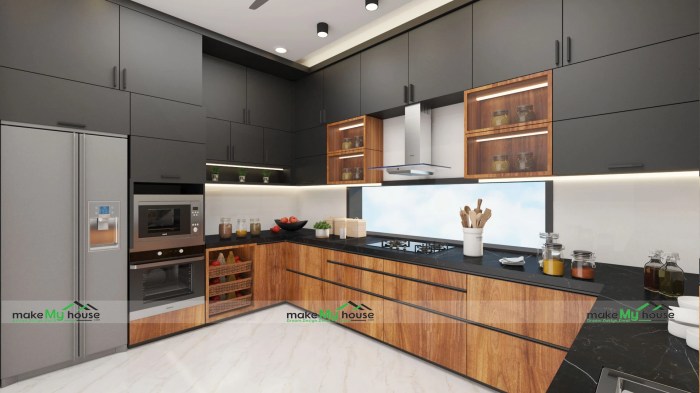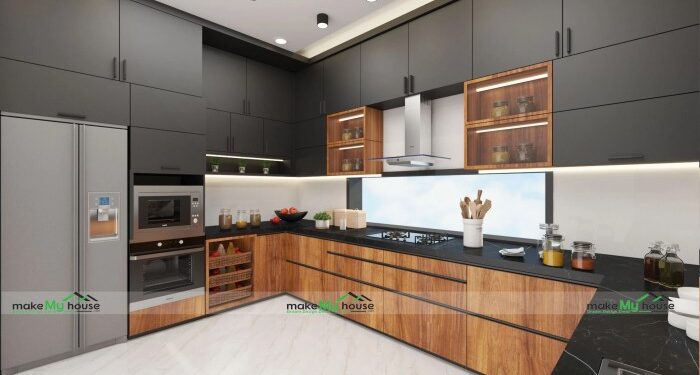Embark on a journey into the world of kitchen interior design, where functionality meets aesthetics in the most harmonious way. From layout to lighting, every element plays a crucial role in creating the perfect culinary space.
Explore how the right design choices can transform a mundane cooking experience into a delightful culinary adventure.
Importance of Kitchen Interior Design
When it comes to designing a kitchen, the interior design plays a crucial role in combining functionality with aesthetics. A well-designed kitchen not only enhances the overall cooking experience but also adds value to a home.
Enhancing Functionality
One of the key aspects of kitchen interior design is maximizing the efficiency of the space. Properly planned layouts, storage solutions, and ergonomic designs can make cooking and meal preparation more convenient and enjoyable. For example, having a well-organized kitchen with ample countertop space, easy access to utensils, and efficient workflow can significantly improve the cooking experience.
Boosting Aesthetics
In addition to functionality, the aesthetic appeal of a kitchen is equally important. The use of colors, materials, lighting, and decorative elements can create a welcoming and visually pleasing environment. Aesthetically pleasing kitchens can inspire creativity, elevate mood, and make the cooking process more enjoyable.
Increasing Home Value
A well-designed kitchen is a major selling point for homes. Potential buyers are often drawn to kitchens that are not only functional but also visually appealing. Investing in quality kitchen interior design can significantly increase the overall value of a property, making it more attractive to potential buyers and increasing the resale value.
Elements of Kitchen Interior Design
When designing a kitchen space, there are several key elements to consider that can greatly impact the overall aesthetic and functionality of the room.
Layout
The layout of a kitchen is essential in determining how efficient and practical the space will be. Consider factors such as the work triangle (the relationship between the stove, sink, and refrigerator), traffic flow, and accessibility to essential items.
Color Scheme
The selection of colors in a kitchen can greatly influence the mood and atmosphere of the space. Lighter colors can make a small kitchen feel more spacious, while bold colors can add personality and warmth. It is important to choose a color scheme that complements the overall design style and reflects your personal taste.
Lighting
Proper lighting is crucial in a kitchen for both practical and aesthetic reasons. Task lighting is essential for food preparation and cooking, while ambient lighting can create a warm and inviting atmosphere. Consider incorporating a mix of overhead lighting, under cabinet lighting, and decorative fixtures to achieve the desired effect.
Materials
The selection of materials in a kitchen can greatly impact the design aesthetic. High-quality materials such as granite countertops, hardwood flooring, and stainless steel appliances can elevate the overall look of the space. Consider durability, maintenance, and cost when choosing materials for your kitchen design.
Storage Solutions
Effective storage solutions are essential in optimizing kitchen functionality. Consider incorporating cabinets, drawers, and pantry space to keep the kitchen organized and clutter-free. Utilize innovative storage solutions such as pull-out shelves, lazy Susans, and vertical dividers to maximize storage capacity and make the most of the available space.
Popular Design Styles for Kitchens
When it comes to kitchen interior design, there are several popular design styles that homeowners can choose from to create a space that reflects their personal taste and lifestyle. Each design style has its own unique characteristics, aesthetics, and functionality, allowing for a wide range of options to suit different preferences.
Modern
Modern kitchen design is characterized by clean lines, sleek surfaces, and a minimalist approach. This style often features materials such as stainless steel, glass, and concrete, creating a contemporary and sophisticated look. To implement a modern design in a kitchen space, one can opt for flat-panel cabinets, a monochromatic color scheme, and integrated appliances for a seamless and streamlined appearance.
Farmhouse
Farmhouse kitchen design is inspired by the charm and warmth of rural farmhouses. This style typically incorporates natural elements like wood, rustic finishes, and vintage accents to create a cozy and inviting atmosphere. To achieve a farmhouse look in a kitchen, one can use shaker-style cabinets, open shelving, a farmhouse sink, and distressed wood finishes for a timeless and homely feel.
Minimalist
Minimalist kitchen design focuses on simplicity, functionality, and a clutter-free environment. This style emphasizes clean, uncluttered spaces, neutral colors, and efficient storage solutions. To create a minimalist kitchen, one can opt for handle-less cabinets, hidden appliances, and a neutral color palette to achieve a sleek and contemporary look.
Industrial
Industrial kitchen design draws inspiration from warehouses and factories, featuring raw materials like exposed brick, metal accents, and concrete surfaces. This style embraces an unfinished and edgy aesthetic, incorporating elements like pendant lighting, open shelving, and industrial-style fixtures for a modern and urban look.
Traditional
Traditional kitchen design exudes elegance, warmth, and timeless appeal. This style often includes classic elements like ornate cabinetry, decorative molding, and intricate details for a refined and sophisticated look. To create a traditional kitchen, one can incorporate raised-panel cabinets, a large kitchen island, and decorative lighting fixtures for a luxurious and timeless space.
Maximizing Space in Small Kitchens

When dealing with a small kitchen, every inch of space counts. Maximizing space in a small kitchen is essential to ensure functionality and efficiency. By implementing smart design solutions, you can make the most out of your limited kitchen space.
Importance of Multifunctional Furniture and Storage Solutions
Utilizing multifunctional furniture and storage solutions is crucial in small kitchens. Opt for kitchen islands with built-in storage, pull-out pantry shelves, and fold-down tables to create additional workspace when needed. Wall-mounted shelves and hanging racks can also help free up valuable counter and cabinet space.
Clever Design Ideas for Small Kitchens
- Utilize vertical space by installing tall cabinets or shelving units to maximize storage.
- Opt for light-colored cabinetry and countertops to create an open and airy feel.
- Consider installing sliding doors or pocket doors to save space compared to traditional swinging doors.
- Use mirrors to visually expand the space and reflect natural light.
- Choose appliances that are scaled down in size to fit better in a small kitchen.
End of Discussion
In conclusion, kitchen interior design is not just about looks; it's about creating a space that enhances daily living and adds value to your home. Dive into the realm of design possibilities and make your kitchen a true reflection of your style and personality.
FAQ Corner
How does kitchen interior design impact the value of a home?
Kitchen interior design can significantly increase the value of a home as it is one of the key areas that potential buyers look at. A well-designed kitchen can make a lasting impression and increase the overall appeal of the property.
What are some popular design styles for kitchens?
Popular kitchen design styles include modern, farmhouse, and minimalist. Each style brings its unique aesthetic and functionality to the kitchen space.
How can I maximize space in a small kitchen?
To maximize space in a small kitchen, consider using multifunctional furniture, clever storage solutions, and light color schemes to create an illusion of space. Utilizing vertical storage and decluttering regularly can also help in optimizing space.
















